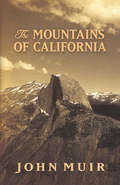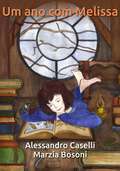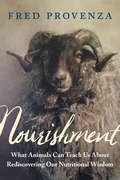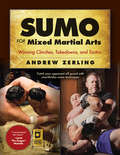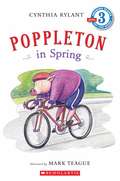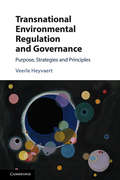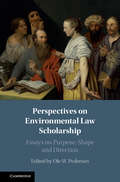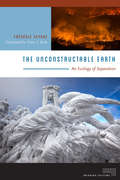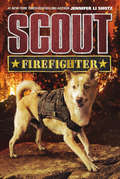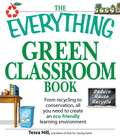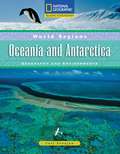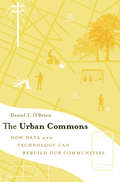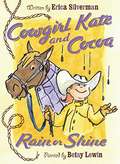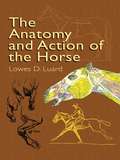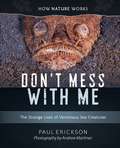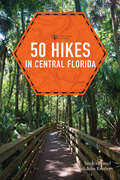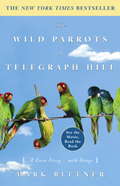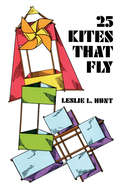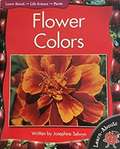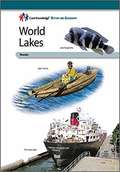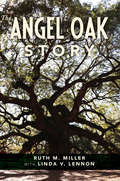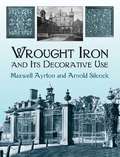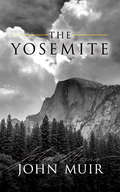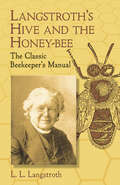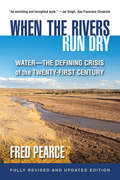- Table View
- List View
The Mountains of California (Large Print Ser.)
by John MuirA great hero of America's conservation movement, John Muir (1838–1914) was active in establishing the Yosemite Valley as a protected national park and in awakening interest in the importance of safeguarding natural resources. In this tribute to the grandeur of the Sierras, Muir recounts his journeys by foot through the Yosemite Valley, Mount Whitney, the famed sequoia forests, King's Canyon, and other wilderness areas. With a natural historian's keen eye for flora, geography, and geology, Muir describes glaciers, lakes, trees, and the daily lives of the region's inhabitants. His lyrical narrative, imbued with the deepest understanding and respect for nature, examines the ways in which natural forces shape the landscape and the effects of the changing seasons. The zesty travelogue is accompanied by splendid illustrations of maps, plants, and animals. Originally published in 1894, The Mountains of California continues to delight and inform readers.
Um Ano com Melissa
by Alessandro Caselli Marzia BosoniSeis contos para crianças que tratam de ecologia e de respeito Respeito pelo meio ambiente, pelos animais e por nós mesmos: eis do que tratam os diálogos entre Melissa, uma menina de seis anos com muita vontade de entender o mundo, e o Senhor Gato, um esperto gato de rua. Seis histórias para contar um ano da vida da menina e para compartilhar um pouco da sabedoria que o gato conquistou pelas ruas do mundo. Entre uma história e outra, o gato se dirige aos pais, e aos adultos em geral, para pedir também a eles para parar um momento e refletir sobre temas importantes como a ecologia, a poluição, a dor e a amizade. Um livro para crianças, mas também um livro para adultos que ainda sabem encontrar tempo para falar com os pequenos. E com os Gatos.
Nourishment: What Animals Can Teach Us about Rediscovering Our Nutritional Wisdom
by Fred ProvenzaReflections on feeding body and spirit in a world of change <P><P> Animal scientists have long considered domestic livestock to be too dumb to know how to eat right, but the lifetime research of animal behaviorist Fred Provenza and his colleagues has debunked this myth. Their work shows that when given a choice of natural foods, livestock have an astoundingly refined palate, nibbling through the day on as many as fifty kinds of grasses, forbs, and shrubs to meet their nutritional needs with remarkable precision. <P><P> In Nourishment Provenza presents his thesis of the wisdom body, a wisdom that links flavor-feedback relationships at a cellular level with biochemically rich foods to meet the body’s nutritional and medicinal needs. Provenza explores the fascinating complexity of these relationships as he raises and answers thought-provoking questions about what we can learn from animals about nutritional wisdom. <P><P> What kinds of memories form the basis for how herbivores, and humans, recognize foods? Can a body develop nutritional and medicinal memories in utero and early in life? Do humans still possess the wisdom to select nourishing diets? Or, has that ability been hijacked by nutritional “authorities”? Consumers eager for a “quick fix” have empowered the multibillion-dollar-a-year supplement industry, but is taking supplements and enriching and fortifying foods helping us, or is it hurting us? <P><P> On a broader scale Provenza explores the relationships among facets of complex, poorly understood, ever-changing ecological, social, and economic systems in light of an unpredictable future. To what degree do we lose contact with life-sustaining energies when the foods we eat come from anywhere but where we live? To what degree do we lose the mythological relationship that links us physically and spiritually with Mother Earth who nurtures our lives? <P><P> Provenza’s paradigm-changing exploration of these questions has implications that could vastly improve our health through a simple change in the way we view our relationships with the plants and animals we eat. Our health could be improved by eating biochemically rich foods and by creating cultures that know how to combine foods into meals that nourish and satiate. Provenza contends the voices of “authority” disconnect most people from a personal search to discover the inner wisdom that can nourish body and spirit. That journey means embracing wonder and uncertainty and avoiding illusions of stability and control as we dine on a planet in a universe bent on consuming itself.
Sumo for Mixed Martial Arts: Winning Clinches, Takedowns, & Tactics
by Andrew ZerlingCATCH YOUR OPPONENT OFF GUARD WITH WINNING CLINCHES, TAKEDOWNS, AND TACTICS This innovative book demonstrates how the study of sumo wrestling techniques can benefit practitioners of modern mixed martial arts (MMA), as well as other grappling arts. Sumo, Japan's ancient martial art, has its own particular variations of MMA-style body locks, throws, and trips, among other techniques. MMA competitors know their sport grew with the evolution of jujitsu, but many do not realize sumo can be seen as the root of jujitsu. Sumo uses distraction, angles, and leverage to steal an opponent's balance and take him down. Sumo for Mixed Martial Arts focuses on kimarite, or winning moves. Knowledge of these techniques can allow competitors to catch their opponents off guard with unorthodox clinches, takedowns, and tactics. The author places special emphasis on how smaller players can defeat larger adversaries. This book features * In-depth demonstrations of 48 sumo kimarite (winning moves) with step-by-step instructions * Over 300 photos * Case studies of famous rikishi (sumo wrestlers) * Discussion of sumo's development, rules, and training, as well as recent changes in sumo techniques The author Andrew Zerling, provides analysis of the three basic types of fighters in MMA and how sumo techniques and tactics can enhance their skills. He examines the fighting style of former UFC light heavyweight champion Lyoto Machida, who made highly effective use of sumo wrestling in MMA competition. In Sumo for Mixed Martial Arts Andrew Zerling casts an ancient martial art in new light. He combines his decades of training with a passion for research. MMA competitors, grapplers, wrestlers, and fans of sumo will appreciate the author's analysis and attention to detail. They will also come away with a wealth of new techniques.
Poppleton in Spring (Fountas & Pinnell LLI Blue #Level J)
by Cynthia RylantRevisit three wonderful stories from Newbery Medalist Cynthia Rylant and award-winning illustrator Mark Teague--with new cover art and design! <P><P>In this easy-to-read chapter book, Poppleton the pig charms young readers with his quirky adventures, whimsical ideas, and engaging community of friends! In three wonderful springtime stories, Poppleton tries his hand at spring cleaning, riding a bike, and staying up all night in his new tent. <P><P>These hilarious stories feature simple language, everyday experiences, and beautiful illustrations--perfect for beginning readers! <P><P>Lexile Measure: 500
Transnational Environmental Regulation and Governance: Purpose, Strategies and Principles
by Veerle HeyvaertA large and growing proportion of contemporary environmental regulation is transnational, which means that it is impossible to understand environmental governance without a firm grasp of the nature of transnational environmental regulation (TER). In this illuminating work, Veerle Heyvaert offers readers a comprehensive discussion of TER, including analysis of international environmental agreements, regional and EU regulation, private environmental regulation, and governance networks, arguing that TER is highly diverse but sufficiently cohesive to allow the identification of shared characteristics that establish TER as a model of regulation. The book uncovers the key features of TER, and analyses the various intentions of TER regulators, TER's governance principles and compliance strategies, using a newly developed activity-based methodology for regulatory analysis. This book should be read by anyone seeking to understand the strengths and weaknesses of transnational environmental governance and its contribution to sustainability.
Perspectives on Environmental Law Scholarship: Essays on Purpose, Shape and Direction
by Ole W. PedersenThis collection invites environmental law scholars to reflect on what it means to be an environmental law scholar and to consider how and why environmental law scholars engage in environmental law scholarship. Leading environmental law scholars from different backgrounds and jurisdictions offer their personal reflections on the nature, form, quality and challenges of environmental law scholarship. The collection offers the first honest introspection on what environmental law scholarship is and is not. It considers the unique contributions of environmental law scholarship to legal scholarship more generally, reflecting on what sets environmental law scholarship apart from other disciplines of legal scholarship and the challenges arising from these differences.
The Unconstructable Earth: An Ecology of Separation (Meaning Systems)
by Frédéric NeyratWinner, French Voices Award for excellence in publication and translation.The Anthropocene announces a post-natural planet that can be remade at will through the process of geoengineering. With it, a new kind of power, geopower, takes the entire Earth, in its social, biological, and geophysical dimensions, as an object of knowledge, intervention, and governmentality. This shift has been aided, wittingly or not, by theorists of the constructivist turn who have likewise called into question the divide between nature and culture and have thus found themselves helpless against the project to replace Earth with Earth 2.0.Against both camps, this book confronts the unconstructable Earth, proposing an “ecology of separation” that acknowledges the wild, subtractive capacity of nature. Against technocratic delusion, but equally against a racially tinged organicism, Neyrat shows what it means to appreciate Earth as an unsubstitutable becoming that cannot be replicated in a laboratory and that always escapes the hubris of those who would remake and master it.
Scout: Fire Fighter (Scout #2)
by Jennifer Li ShotzThe second installment of the action-packed Scout series, from the #1 New York Times bestselling author Jennifer Li Shotz.It’s official: Scout is now a K9 in the National Guard. But being a certified hero means Scout has his job cut out for him. He needs to work even harder to protect his country and his human best friend, Matt. When Matt’s classmates get trapped in a raging wildfire, Matt knows that only Scout can track them down and bring them back safely. But when Matt’s dad, a First Sergeant home on leave, gets wind of their plan, he insists on joining the rescue mission.Can the heroic team save Matt’s friends from the dangerous fires before time runs out? This fast-moving tale of Scout the hero dog will grab even reluctant readers and is perfect for fans of Cracker!, Max, and Hero.
Green Classroom Book: From Recycling to Conversation, All You Need to Create an Eco-Friendly Learning Environment (The Everything®)
by Tessa HillThis book is the essential guide for teaching children about nature and environmental protection. This guide shows teachers how to incorporate “green” concepts into everyday lessons, activities, and field trips. Also included are ways to send the lesson home, with clear steps for teaching children how to make saving the earth a part of their daily lives. Features information on:The best ways to address issues like global warming and the disappearing rainforests Sustainable school suppliesEco-friendly fundraisingInspiring field trip ideas (from the local farm to the local landfill!)Innovative ways to reduce, reuse, and recycleTeachers, students, administrators, and parents will learn to take green practices from the classroom to the larger world outside. By using teacher-tested activities and the inspiring stories of real kids, this book will motivate teachers and their students to turn education into action.
Reading Expeditions: Geography and Environments, 1st Edition (Reading Expeditions Ser.)
by Carl Proujan National Geographic Learning StaffExplore the unique landscapes and wildlife of Australia, New Zealand, the Pacific Islands, and Antarctica. Discover what forces caused different environments to form and how this diverse geography affects how people live.
The Urban Commons: How Data and Technology Can Rebuild Our Communities
by Daniel T. O'BrienThrough voicemail, apps, websites, and Twitter, Boston’s sophisticated 311 system allows citizens to report potholes, broken streetlights, graffiti, and vandalism that affect everyone’s quality of life. Drawing on Boston’s rich data, Daniel T. O’Brien offers a model of what smart technology can do for cities seeking both growth and sustainability.
Rain or Shine (Fountas & Pinnell LLI Blue #Level K)
by Erica SilvermanCowgirl Kate and her cow horse, Cocoa, discover what it means to work, play, and be together- rain or shine.
The Anatomy and Action of the Horse
by Lowes D. LuardThis easy-to-read text explains the horse as a machine designed for movement. Using different colors in his drawings, the author not only describes with clarity the horse's skeleton and the functions of various muscles, but also creates images that have the power to suggest movement and stress. More than 75 illustrations include accurate diagrams and color illustrations fo the horse's anatomy, as well as meticulously rendered sketches of the entire animal.Of value to students and teachers of art, this book will also appeal to horse lovers who want a deeper understanding -- without having to examine the anatomical complexities of the subject -- of why this animal is capable of moving with such grace and speed.
Don't Mess With Me: The Strange Lives Of Venomous Sea Creatures (How Nature Works #0)
by Paul Erickson Andrew MartinezThe role of venoms in nature … and in human medicine Why are toxins so advantageous to their possessors as to evolve over and over again? What is it about watery environments that favors so many venomous creatures? Marine biologist Paul Erickson explores these and other questions with astounding images from Andrew Martinez and other top underwater photographers. GREAT for teaching STEM Marine Biology Scorpions and brown recluse spiders are fine as far as they go, but if you want daily contact with venomous creatures, the ocean is the place to be. Blue-ringed octopi, stony corals, sea jellies, stonefish, lionfish, poison-fanged blennies, stingrays, cone snails, blind remipedes, fire urchins—you can choose your poison in the ocean. Venoms are often but not always defensive weapons. The banded sea krait, an aquatic snake, wriggles into undersea caves to prey on vicious moray eels, killing them with one of the world’s most deadly neurotoxins, which it injects through fangs that resemble hypodermic needles.
50 Hikes in Central Florida: Hikes, Walks, And Backpacks In The Heart Of The Peninsula (Explorer's 50 Hikes Ser. #0)
by Sandra Friend John KeatleyA Florida hike for every interest and ability Florida’s landscape is a marvel of diversity, and Central Florida is its pinnacle. Footpaths range through salt marshes, river floodplains, and along coastal dunes and beaches. Trails pass through desert- like scrub islands, jungle- like hydric hammocks, and deep, dark bayous. There’s no better way to take in this natural world than by walking it. Ranging from 1 to 43 miles in length, each hike includes directions, a detailed map, and information on hike duration, difficulty, and trail conditions. Explore a new side of Florida, from hidden urban gems like the Circle Bar B Ranch in Lakeland and Ponce Preserve in Daytona Beach, to the quiet rural landscapes of Catfish Creek State Park and Chinsegut Hill.
The Wild Parrots of Telegraph Hill: A Love Story . . . with Wings
by Mark BittnerThe Wild Parrots of Telegraph Hill is the inspiring story of how one man found his life's work--and true love--among a gang of wild parrots roosting in one of America's most picturesque urban settings. Mark Bittner was down on his luck. He'd gone to San Francisco at the age of twenty-one to take a stab at a music career, but he hadn't had much success. After many years as an odd-jobber in the area, he accepted work as a housekeeper for an elderly woman. The gig came with a rent-free studio apartment on the city's famed Telegraph Hill, which had somehow become home to a flock of brilliantly colored wild parrots. In this unforgettable story, Bittner recounts how he became fascinated by the birds and made up his mind to get to know them and gain their trust. He succeeds to such a degree that he becomes the local wild parrot expert and a tourist attraction. People can't help gawking at the man who, during daily feedings, stands with parrots perched along both arms and atop his head. When a documentary filmmaker comes along to capture the phenomenon on film, the story takes a surprising turn, and Bittner's life truly takes flight.From the Hardcover edition.
25 Kites That Fly
by Leslie HuntWith this book by Leslie Hunt, kite-maker for the United States Weather Bureau, you can make your own, personalized kites that will fly in all degrees of wind, from the most imperceptible breeze to a gale. All that you need are some light wood (or substitute), glue, wire, hammer, and nails — plus the clear, concise explanations offered in this book.Twenty-five basic kites are covered in constructional details: standard two-stick kites; six-point stars; figural kites such as imps, fishermen, elephants, owls, shields; balloon kites; tetrahedral kites; various kinds of box kites with and without wings; really strong military kites; and many other varieties. Nor are you limited to the kites that are presented in detail: the carefully thought-out, complete instructions are meant to encourage you to experiment with more unusual effects, since they explain important points of design and operation that make all kites fly well.The author explains materials and methods quite thoroughly, with consideration of sticks and surface, types of glue, stringing, making composite sticks, tails, bridles, and many other elements, He also gives information on many of the fascinating accessories and concomitants to kites; messengers (or elements that move between ground and kite), parachutes, time releases, special effect releases, tandem kites, and kite photography. He also explains very clearly the method of getting a kite to fly, reeling and stringing, and determining altitude.
Flower Colors (Fountas & Pinnell LLI Blue #Level B)
by Josephine SelwynPart of the Learn-Abouts guided reading program, this beginning reader introduces a nonfiction topic, with the use of a picture dictionary.
World Lakes (Core Knowledge History and Geography)
by Core Knowledge FoundationWORLD LAKES begins with a review of map skills and geographical terms. Students learn about the benefits and resources provided by lakes, including, in Asia, the Caspian and Aral Seas; in Africa, Lakes Victoria, Tanganyika, and Chad; in South America, Lakes Maracaibo and Titicaca; and, in North America, Lakes Superior, Huron, Michigan, Erie, and Ontario.
The Angel Oak Story
by Ruth M. Miller Linda V. LennonAngel Oak is estimated to be more than 400 years old. The story of the live oak begins with the "purchase" of Johns Island from the Cussoe Indians by a representative of Sir Anthony Ashley Cooper in 1675. The land upon which the tree grows was then granted to Abraham Waight in 1717. The oak garnered its name when descendant Martha Waight married Justus Angel. This same family maintained ownership of the property for 242 years. Today, the Angel Oak is owned by the City of Charleston. Authors Ruth M. Miller and Linda Lennon describe life on Johns Island through 300 years and the special place the tree has held in the hearts of Lowcountry residents. A foreword was provided by Becky Woods, communications manager for the Lowcountry Land Trust.
Wrought Iron and Its Decorative Use
by Arnold Silcock Maxwell AyrtonA superb treasury of decorative wrought iron, this well-illustrated volume presents an informative survey of the ancient craft's practice throughout England. Its history can be traced simply by admiring the crisp black-and-white illustrations of gates, railings, screens, and other elaborately rendered works. 241 black-and-white illustrations.
The Yosemite: Illustrated Edition (Mobi Classics Series)
by John MuirAn essential companion for visitors, this book by the famed conservationist offers informed appraisals of Yosemite's plant and animal life and exudes an almost mystical love for its natural beauty.
Langstroth's Hive and the Honey-Bee: The Classic Beekeeper's Manual
by L. L. LangstrothThe first descriptive treatise of modern bee management. In a reader-friendly, enthusiastic style, Langstroth addresses every aspect of beekeeping: bee physiology; diseases and enemies of bees; the life-cycles of the queen, drone, and worker; bee-hives; the handling of bees; and many other topics. 25 plates.
When the Rivers Run Dry, Fully Revised and Updated Edition: Water-The Defining Crisis of the Twenty-First Century
by Fred PearceA new edition of the veteran science writer's groundbreaking work on the world's water crisis, featuring all-new reporting from the most recent global flashpointsThroughout history, rivers have been our foremost source of fresh water for both agriculture and individual consumption, but looming water scarcity threatens to cut global food production and cause conflict and unrest. In this visionary book, Fred Pearce takes readers around the world on a tour of the world's rivers to provide our most complete portrait yet of the growing global water crisis and its ramifications for us all. With vivid on-the-ground reporting, Pearce deftly weaves together the scientific, economic, and historic dimensions of the water crisis, showing us its complex origins--from waste to wrong-headed engineering projects to high-yield crop varieties that have saved developing countries from starvation but are now emptying their water reserves. Pearce argues that the solution to the growing worldwide water shortage is more efficiency and a new water ethic based on managing the water cycle for maximum social benefit rather than narrow self-interest.
